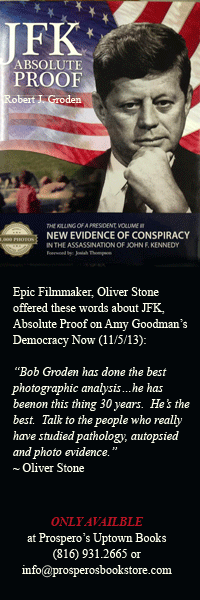 For decades, Film Row – the area between 17th and 19th streets on Central and between Wyandotte and Broadway on 18th Street – was the midwest’s connection to the movie biz.
For decades, Film Row – the area between 17th and 19th streets on Central and between Wyandotte and Broadway on 18th Street – was the midwest’s connection to the movie biz.
All the major Hollywood studios had distribution offices there. Warner Brothers, 20th Century-Fox, Columbia Pictures, Paramount, Allied Artists, MGM, Universal Pictures, United Artists, Walt Disney and a handful of independents. Each facilitated the distribution of motion pictures to the midwest’s theater screens from what is now called the Crossroads district.
The tall building at the SW corner of 18th and Wyandotte was the national headquarters of the biggest distributor of movie advertising accessories. Known as National Screen Service, it shipped trailers, posters and ad materials to theaters all across the country.
The N.S.S also stored a vast supply of all sorts of movie marketing pieces dating back to who-knows-when. A genuine film museum of sorts.
This relatively small area of KC was a very special community unto itself.
It even had its own bar and restaurant called the Screenland Cafe. It contained two screening rooms and was home to two large regional theater circuits—Commonwealth Theatres, Inc. and Durwood Theatres, which would later grow into one of the largest exhibition companies known today as AMC Entertainment.
Film Row’s (near) last breath came at the end of the 1980’s when yours truly was one of the last ones to shut down the Commonwealth’s home office where I’d been employed as Director of Marketing for more years than I care to remember.
Now fast forward to 2011, when movie studios announced at CinemaCon in Las Vegas that motion picture film prints would soon disappear altogether.
Disappear!
After 2013, ALL movies projected at the nation’s theaters will be only be in the digital format.
Note: About half of Kansas City’s currently operating screens have already been converted to this much cleaner, crisper and ultimately less expensive process of movie distribution.
The digital changeover in theaters also puts the final nail in the coffin of Kansas City’s last connection to its long film history—namely the Film Depots.
Through the week, movie studios would bulk ship a sizable number of 35 mm prints directly from the labs to the regional DeLuxe film depot located in a nondescript warehouse in North Kansas City.
There the film prints would be mounted, stored and eventually trucked to area theaters in those bulky metal cans.
But film can shipping volume has been declining as more theaters have made the switch to digital projection.
And after this week, K.C.’s only remaining film depot will be just another cinematic memory.
(Until film prints finally disappear forever, they will be shipped to midwestern theaters from an out of state distribution point.)
So farewell to yesteryear’s celluloid technology. It’s been a good, LONG ride.
And before long, when someone says they’re going to see a certain ‘film,’ you’ll be able to set them straight










Question
What happens to theatres that can’t afford to buy new digital equipment. Are they just going to go away? Doesn’t seem fair.
Digital rocks …
.. waiting for the ‘digital sucks’ post.
Gene, yes.
digital sucky
I still prefer the true film look. Digital looks too harsh and has no warmth. Bet even Glazer wouldn’t do a digital bimbo. Then again he might.
Bound To Happen
Well Jack we are getting old and have seen many things change over the years. I know it’s just hard sometimes to think something you have been a part of for so many years is coming to an end.
I remember when Max Floyd said to hell with them I will never play CD’s. Well now look where we are. Downloading music and film off the internet into our homes everyday.
To Super Dave…..
…AMEN, my friend. (Just as long as you’re downloading the movies LEGALLY. There’ve been some mighty big fines dished out to some unlucky stiffs who did it illegally!!!!)
Digital projection is great for indie filmmakers
Digital projection enable independent films, including ones made right here in Kansas City, to be screened in any theatre anywhere in the country without the hefty cost of printing and mailing film stock. Instead of bemoaning what is lost, consider what this enables for filmmakers everywhere. It’s an opportunity to tear down the gatekeepers of distribution that has been largely controlled by the big Hollywood studios.
Distribution is the one place that the independent film movement failed to gain a foothold. Independent producers figured out how to make movies, but they couldn’t get them into theatres without distribution help from Hollywood. Hollywood played their game, made their own “indie” movies, and commandeered the indie film movement. Then they figured out it wasn’t that profitable and when the economy went south, they shuttered all their indie film arms. Independent film is in shambles with nothing but a handful of film festivals to give it exposure.
Indie filmmakers need digital projection and Netflix streaming if their pictures are ever going to get an audience. It helps level the playing field against Hollywood. Then again, if all you ever watch is movies based on comic books, you probably don’t care about any of this.